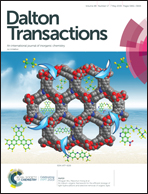Highly linear polyethylenes tailored with 2,6-bis[1-(p-dibenzo-cycloheptylarylimino)ethyl]pyridylcobalt dichlorides†
Abstract
A novel family of 2,6-bis[1-(p-dibenzocycloheptylarylimino)ethyl]pyridylcobalt dichlorides Co1–Co4 were synthesized and fully characterized by FT-IR, 1H NMR, and elemental analysis as well as X-ray diffraction analysis. The 1H NMR spectra of these paramagnetic cobalt complexes Co1–Co3 showed similar spectra with one set of signals, while Co4 possessed two sets of signals due to the different conformations caused by different substituents on the ortho-position of the N-aryl group. Crystal structures of Co1, Co2 and Co4 revealed similar square-pyrimidal geometry around the cobalt ion, in which two dibenzocycloheptyl groups adapted as cis-conformers, whereas Co3 possessed bistrigonal geometry and the two dibenzocycloheptyl groups were adapted as trans-conformers. On activation with methylaluminoxane (MAO) or modified MAO (MMAO), all these cobalt complexes displayed high catalytic activities towards ethylene polymerization (up to 1.21 × 107 g (PE) mol−1 (Co) h−1) and produced polyethylenes with narrow molecular distributions (PDI ≈ 2.0). Co3 bearing bulkier isopropyl substituents on the ortho-position gave much higher molecular weight of resultant polyethylene than the other cobalt complexes reported herein. The microstructure analysis of the PEs demonstrated that they are highly linear and contain a vinyl end group as the major group and saturated methyl as the minor group, in which the content of the unsaturated polymer chain relied on the ortho-substituent of the N-aryl group.
![Graphical abstract: Highly linear polyethylenes tailored with 2,6-bis[1-(p-dibenzo-cycloheptylarylimino)ethyl]pyridylcobalt dichlorides](/en/Image/Get?imageInfo.ImageType=GA&imageInfo.ImageIdentifier.ManuscriptID=C9DT01109A&imageInfo.ImageIdentifier.Year=2019)


 Please wait while we load your content...
Please wait while we load your content...